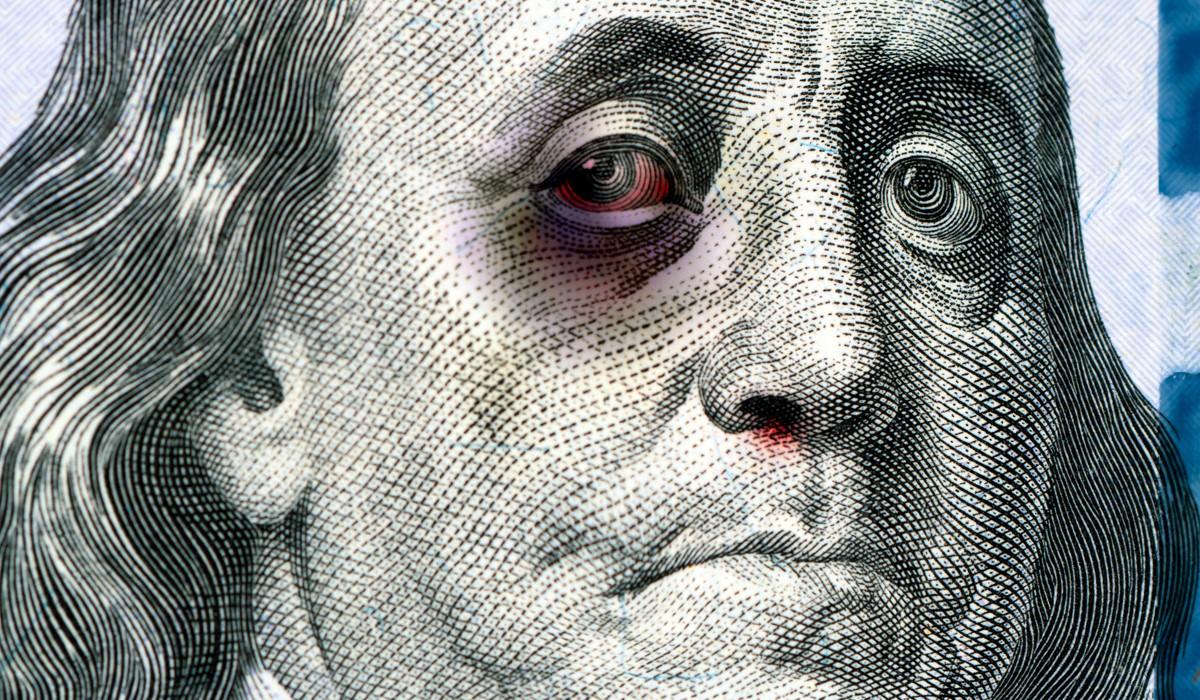
Price inflation in the United States remains stubbornly high, with October’s print at 7.7 percent. The Fed’s preferred measure, so-called core inflation is only two-tenths of a percent below 40-year highs, at 6.3 percent. Yet, it was just last year that the Federal reserve and other “experts” were concerned that inflation wasn’t high enough. In January 2021, for example, Jerome Powell stated that the Fed wanted price inflation to run above the “2-percent goal” because it had run below 2 percent for too long. The 2-percent inflation target, of course, is the arbitrary target picked by the Federal Reserve (and many other central banks) as the “correct” inflation rate.
Now with inflation running near 40-year highs, many are wondering what will be necessary to bring price inflation back down to the target level. More specifically, how many hikes in the target interest rate will be necessary, and how severe of a recession will be required? Wall Street is especially interested in the answer to this question because Wall Street is no longer about fundamentals. Rather, the “market” depends overwhelmingly on how much easy money the central bank pumps out. Naturally, the banker class wants a return to “normal”—i.e., quantitative easing and ultralow interest rates—as soon as possible. Moreover, Washington wants the same thing since the political class wants low interest rates to help ease the path to ever more government debt and higher deficits.
It’s not the least bit surprising that we’re already hearing calls for the Federal Reserve to abandon the 2-percent inflation target and instead embrace even higher perpetual inflation rates. For example, last week Bank of America economist Ethan Harris suggested that the 2-percent target CPI inflation rate be raised. We’ve seen similar urgings from both the Wall Street Journal and from think tank economists in recent months.
The push for higher inflation rates is just the latest reminder that wealthy bankers and other members of the ruling class aren’t harmed by price inflation the way that ordinary people are. Billionaires and technocrats often benefit—either financially or politically—from high price inflation. We should expect to see growing pressure from Wall Street and Washington insiders if the Fed actually attempts to keep any modicum of monetary tightening going into next year.
Wall Street Wants More “Flexibility” for the Central Bank
Harris’s comments for Bank of America help reveal how comfortable Wall Street is with high price inflation. Harris began by stating that “there is nothing special about 2% other than the fact that it is the official target in many countries.” Harris is right, but his intentions in doing so are unfortunate. Harris merely points to the arbitrary nature of the 2-percent standard in order to call for a more activist Federal Reserve. Harris claims “The evidence is that steady 4% inflation imposes very small additional costs compared to steady 2% inflation. Either way the economy adapts. …Perhaps the inflation target should be 3 or 4%?”
The part about the market adapting is especially capricious. It seems that for banker economists detached from real people and the real economy, the “economy” is an abstract thing that “adapts” and there’s really no need to worry about it.
The “economy” however is not some mere idea, but is composed of actual people. For ordinary people, it’s a little more difficult to “adapt” when one’s wages are negative in real terms—as has now been the case for months—or when the boom-bust cycle brought on by inflationary monetary policy leads to unemployment. Middle-class pensioners whose fixed incomes don’t keep up also don’t find it so easy to “adapt.”
Investment bankers and billionaires with hedge funds, on the other hand, can indeed “adapt” because they can simply take on higher and higher levels of risk in the process of searching for yield above the inflation rate. Sure, if things go badly, they may have to sell a vacation home or take a hit on their stock options, but they’ll hardly have to switch to the generic mac and cheese to feed their children.
Harris isn’t alone in pleading for more price inflation. Earlier this month, Wall Street Journal writer Jon Sindreu was already on the same bandwagon when he asked “Why must inflation be around 2%?” He went on to claim that what really matters is not low inflation but stable inflation. Thus, the real problems with inflation “stem from inflation accelerating, not its being high.” Thus, he asks
what if inflation stabilizes at a higher rate—say between 4% and 6%? In this plausible case, central banks may be compelled to start needlessly raising rates again. … Inflation of 4% is perfectly compatible with a healthy economy that isn’t overheating.
This came only a few weeks after the Roosevelt Institute—where New Keynesian economist Joseph Stiglitz is head economist—called for a higher inflation target. Specifically, the Institute wants an inflation “range” from 2 to 3.5 percent using the PCE deflator. This would lead in practical terms to real shift upward in target inflation. After all, according to the PCE measure, price inflation barely exceeded the 3.5 target even at the height of the housing bubble in 2008. In other words, even in a red-hot bubble economy, price inflation could still come in within the preferred range, meaning monetary tightening would almost never be seen as necessary or urgent.
Clearly, the trial balloons for higher target inflation are already being floated, and once CPI inflation returns to anywhere near 4 percent, we should expect to hear howls from Wall Street and Washington about the “need” for the Fed to once again drive down interest rates while propping up asset prices.
How Target Inflation Keeps Moving Up
We’ve been down this road before. 26 years ago, the debate was over whether or not the target inflation rate should be raised to 2 percent. Before that, Congress had put into legislation a target of zero percent.
In the “Full Employment and Balanced Growth Act of 1978” Congress explicitly added a “stable prices” mandate to the Federal Reserve Act, and stated that CPI inflation should be reduced to 3 percent or less. Moreover, by 1988, the Act imagined that the official inflation rate should be reduced to zero:
Upon achievement of the 3 per centum goal … each succeeding Economic Report shall have the goal of achieving by 1988 a rate of inflation of zero per centum.”
The drive for zero-percent inflation had advocates among some monetarists and other “hard money”—”hard” in the relative sense—advocates who opposed the Keynesian consensus that had produced the runaway inflation of the 1970s. The triumph of these hawks was short lived, however, and by the end of the 1980s, the more dovish forces had come to the fore in the form of Alan Greenspan and up-and-coming economists like Janet Yellen. Even Volcker had again moved back toward easy money as can be seen in his support for the Plaza Accord.
In his book The Case Against 2 Per Cent Inflation, economist Brendan Brown writes:
The Volcker Fed’s abandonment of “hard money” policies and the monetarist experiment led directly to the global monetary inflation of the late 1980s featuring virulent asset inflation, most spectacularly the bubble and bust in Japan. Germany was the last to abandon monetarism formally with the launch of the euro.
Within a few years there was the start of anew stabilization experiment-the targeting of perpetual inflation at 2% p.a. A key milestone was the FOMC meeting of July 1996 which considered the issue of whether with inflation now down to below 3% the Fed should go easy on its drive to ever-lower inflation and accept a continuing stable low inflation around 2%. Janet Yellen presented the paper in favour. There followed no firm resolution. Nevertheless then Chief Greenspan agreed to a pause. A stronger commitment to a target of perpetual “low inflation” emerged in subsequent years, both under the late Greenspan years and more especially under Chief Bernanke.
The European Central Bank’s formal embrace of a 2-percent standard was followed informally by the Fed at first, and then formally adopted in 2012. Even that was short lived. In August 2020, the Fed announced a switch to “average” inflation targeting of 2 percent, which meant the Fed would sometimes target inflation above 2 percent with the goal of 2 percent over time. Now in 2022, we’re talking about hiking the target inflation rate yet again, perhaps to “between 4% and 6%” as The Wall Street Journal suggests. Not mentioned is the fact that the upward creep in inflation targets enabled the Fed to ignore inflation as it relentlessly rose throughout 2021. The Fed at that point wanted inflation well above 2-percent in order to achieve that new “average” of 2 percent. The result was a complacent Fed that let inflation rise to a 40-year high.
The allure of easy money never fades, especially for those who benefit from easy money most. This latter group includes a growing army of zombie corporations, governments mired in debt, and a financialized Wall Street where valuations disregard fundamentals but are based on the ability to borrow at cheap rates and capitalize on rising stock prices. The easy-money chorus couldn’t care less about small entrepreneurs squeezed by high prices, or by old ladies on fixed incomes. All that matters is a return to easy money, and if that means ever higher inflation targets, so be it.







